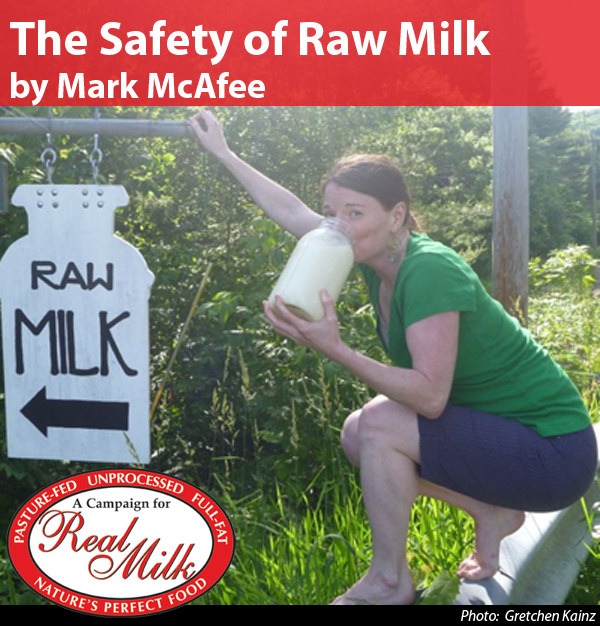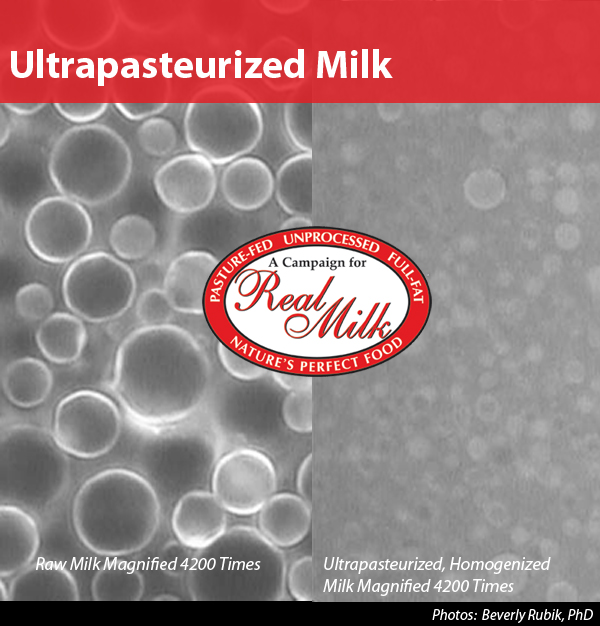


The Safety of Raw Milk
May 19, 2004Victory in Colorado
June 30, 2004Today, an increasing amount of milk found in conventional grocery stores–including most organic milk–is ultrapasteurized. The official U.S. government definition of an ultrapasteurized dairy product stipulates “such product shall have been thermally processed at or above 280° F for at least 2 seconds, either before or after packaging, so as to produce a product which has an extended shelf life under refrigerated conditions.” Confusingly, ultrapasteurized milk is oftentimes referred to as or labeled as UHT, for “ultra-high temperature.” It is the high-temperature processing that gives the milk an extended shelf life (ESL).
Why do processors embrace UHT milk? Because today’s milk is no longer a local product; it is processed in huge processing plants and then shipped all over the country. When packaged in aseptic containers, UHT milk remains stable at room temperature for up to six months. Its extended shelf life with refrigeration in standard packaging, such as plastic bottles, is up to 50 days–enough time for it to be shipped across country, or internationally, and sold to customers far from the milk’s origin.
HARMFUL PROCESS
In the commercial processing of UHT milk, raw milk is first preheated to 176-194° F, then submitted to one of two heating methods: direct or indirect. In the direct method, milk is injected with superheated steam or the milk is sprayed into steam. This raises the temperature of the milk immediately, but also slightly dilutes it. The extra water is removed when the milk is subsequently cooled in a vacuum chamber. Indirect heating occurs by bringing milk into contact with super-heated metal plates that have been heated by steam–hence, the steam is “indirectly” heating the milk. Some new systems combine the two processes.
According to Lee Dexter, microbiologist and owner of White Egret Farm goat dairy in Austin, Texas, ultrapasteurization is an extremely harmful process to inflict on the fragile components of milk. Dexter explains that milk proteins are complex, three-dimensional molecules, like tinker toys. They are broken down and digested when special enzymes fit into the parts that stick out. Rapid heat treatments like pasteurization, and especially ultrapasteurization, actually flatten the molecules so the enzymes cannot do their work. If such proteins pass into the bloodstream (a frequent occurrence in those suffering from “leaky gut,” a condition that can be brought on by drinking processed commercial milk), the body perceives them as foreign proteins and mounts an immune response. That means a chronically overstressed immune system and much less energy available for growth and repair.
RESEARCH
Scientists in Australia, a country with a huge dairy industry, have taken the lead in researching UHT milk. A 2002 paper discusses how UHT processing and subsequent storage causes several changes affecting the shelf life of UHT milk. The changes include: whey protein denaturation, protein-protein interaction, lactose-protein interaction, isomerisation of lactose, Maillard browning which imparts a burnt flavor, sulphydryl compound formation, formation of a range of carbonyl and other flavor-imparting compounds, and formation of insoluble substances. According to the authors Datta and Deeth, these changes “ultimately reduce the quality and limit the shelf life of UHT through development of off flavors, fat separation, age gelation and sedimentation.” Nevertheless, according to the report, the milk remains “commercially stable.”
A thorough reading of their paper reveals a very interesting point. During the heating process, the aforementioned sulphydryl compounds impart a very strong cabbagy off-flavor to UHT milk that is most noticeable immediately after heating. These compounds dissipate during storage, but approximately one month into storage, UHT milk begins to deteriorate and is described in the industry as “stale.” In the later stages of storage, a bitter taste develops and then it undergoes “age gelation,” a process in which the milk becomes more viscous and eventually loses fluidity. So, it seems the optimum time to drink UHT milk with any degree of enjoyment, if that’s even possible, is limited to the interval between the dissipation of the cabbage flavor and the onset of staleness, bitterness and gelatinous conditions. In the U.S., these off-flavors seem to go unnoticed, which makes me wonder whether some kind of flavorings or other chemicals are being added to UHT milk? If the whole industry does this, they don’t need to list such additives on the label because it is an “industry standard.”
PACKAGING
UHT milk was introduced by the Italian dairy company Parmalat, which sold UHT milk in aseptic tetra-brik containers as a convenience food to Europeans, most of whom lived in apartments and had small refrigerators. That strategy didn’t work in the U.S., where almost everyone has a large refrigerator and where consumers still value “fresh” milk. In the early 1990s, in order to overcome American consumer resistance to milk that didn’t need to be refrigerated, Parmalat implemented an aggressive marketing plan as well as a strategy to overcome “regulatory impediments,” hoping to carve out a niche in the U.S. milk market. While little boxes of Parmalat UHT milk can be found in the grocery aisle, most U.S. milk producers package UHT milk in cartons and plastic bottles identical to those containing pasteurized milk.
While UHT milk remains popular in Europe and Brazil, in the United States, consumer resistance has spurred Horizon and Organic Valley, the major producers of organic milk, to reintroduce pasteurized milk in some locations where they have local sourcing and nearby milk plants. In the Washington, DC area, Horizon sells UHT milk in the supermarkets and pasteurized milk in the upscale markets like Whole Foods.
PACKAGING
While the processing of UHT milk creates palatability problems and possible health risks, so does its packaging–both the aseptic boxes and plastic containers. For example, phthalates and other endocrine disrupting compounds (EDC) can leach into the milk. In a recent study published in the Journal of Agricultural and Food Chemistry, investigators measured the presence of nonylphenol (NP), bisphenol A (BPA) and bisphenol A diglycidyl ether (BADGE) in two brands of UHT milk in tetra-brik containers. These containers are designed to be stacked on pallets and are lined with polyethylene. They also looked at EDCs in two brands of milk that had been bottle sterilized (heated to at least 212o F) “for a length of time sufficient to render it commercially sterile” and in one brand of canned powdered infant formula.
All the samples contained measurable levels of endocrine disrupting substances that leaked from the plastic of the containers, or plastic lining the containers. Even when kept cold, plastic will leach some chemicals into the liquid it contains; filling plastic-lined containers with superheated milk or subjecting liquid-filled containers to high heat is a recipe for the release of phthalates and similar substances. The researchers noted that the levels of these compounds in the samples studied did not achieve “the maximum leached level allowed by law.” Their concluding comment, however, is more pessimistic: “. . . the impact these compounds may have on organisms and human beings needs to be further studied, especially with regard to accumulation, degradation and possible effects within the endocrine system.”
UHT MILK IN YOUR FUTURE?
In the fall of 2004, we learned from a dairy inspector in a mid-Atlantic state that the FDA had conducted a nationwide conference call with the dairy departments of all 50 states. There were two reported topics of discussion on the agenda. The first topic concerned raising the required temperature of pasteurization. The stated reason: many organisms have become heat resistant and now survive the pasteurization process. The Johne’s, or paratuberculosis, bacterium, is a good example. Johne’s disease is endemic in today’s confinement dairies and has been linked to Crohn’s disease in humans. Many samples of pasteurized milk now test positive for Johne’s bacteria. B. cereus and botulism spores also survive, as do those of protozoan parasites.
Is the FDA planning to raise the required temperature of pasteurization to that now used in ultrapasteurization? If so, the agency has not yet published an official plan. The 2005 “Program Priorities” for the FDA’s Center for Food Safety and Applied Nutrition (CFSAN) include finding ways to reduce the incidence of foodborne Listeria outbreaks, which includes continuing to develop and deliver State and Federal (web based) curricula for “Listeria control implementation for manufacturers and retail/food service operators.” Whether this is a covert move that will eventually lead to raising the temperature of pasteurization remains to be seen. Such a move would redefine ultrapasteurization as pasteurization so that the words “ultrapasteurization” or UHT might then not have to appear on the label. The industry would certainly be happy about such a move, but would consumers? Any major move in this direction requires the FDA to keep the public informed through an Advance Notice of Proposed Rulemaking (ANPRM), which should include a period for public comment.
The second reported topic of discussion during the FDA dairy meeting was an organization called the Weston A. Price Foundation. We are definitely on their radar screen!
A CULTURE PROBLEM
In the name of science, I decided to do an experiment. I usually make homemade yogurt with a Bulgarian culture and the best quality milk I can find. Raw milk is ideal, but sometimes I have to settle for pasteurized, un-homogenized milk. Both raw and pasteurized, un-homogenized milk produce a firm-textured yogurt with a delectable layer of cream on the top. This time, I bought a quart container of organic Horizon UHT whole milk and cultured it exactly the same way. It took a few hours longer to set up and it never attained the consistency I have come to expect and enjoy. When I tried to spoon some out of the jar, it dissolved into small curds instead of staying in a firm mass on the spoon. It became very watery and unappetizing–and ended up down the sink instead of in my family’s stomach.
At least pasteurized milk will make an acceptable yogurt. Milk that has been sterilized will not. I haven’t noticed the UHT label on any cheese packages either. Since ultrapasteurized or UHT milk will not adequately support microbial life, it is unlikely that it will adequately support human life either. The fact that the processing and storage of UHT milk is so horrendous makes me wonder why they bother. Fermentation is the best way to extend milk’s shelf life and should be re-examined as a better alternative.
Sidebar
THE ENRON OF EUROPE
In the 1950s, Italian scientists published studies with titles like “Ultrapasteurization of milk II. Experimental research on the preservability of ultrapasteurized and pasteurized milk bottled under the same conditions.” Such studies undoubtedly provided the ultrapasteurization know-how to Parmalat Finanziaria, a company started in 1961 by a young Italian entrepreneur named Calisto Tanzi. Today, Dow Jones ranks Parmalat as the world’s number one producer of UHT milk. While Parmalat’s milk may be “stable,” its finances are anything but.
In 2004, Parmalat declared bankruptcy both in Italy and the United States after a major financial crisis that involved efforts to hide huge losses and siphon off money to the founding Tanzi family. Thousands of investors were taken to the cleaners with fancy shell games in the Cayman Islands, a situation that gave Parmalat the name of the European Enron. One such scheme was arrogantly, and appropriately, named Buconero, or black hole.
Shortly after the scandal broke, the U.S. Securities and Exchange Commission filed a lawsuit against Parmalat for selling $1 billion of fraudulent bonds to U.S. investors. On January 7, 2005, although $9 billion in debt and with protests from jilted investors, Parmalat managed to wrangle a $15 million debtor-in-possession credit line from the US Bankruptcy court in Manhattan. Parmalat claimed it needed the line of credit to buy enough fresh milk to keep its dairy operation running and make payroll. Why would any responsible bank lend them this money? A wise man once said, “Owe a little to the bank, and they own you; owe a lot, and you own them.”
References
- Datta, Nivedita, Deeth, Hilton, C. et. al., Australian Journal of Dairy Technology. Vol. 57: No 3. (October 2002), Ultra-high-temperature (UHT) treatment of milk: comparison of direct and indirect modes of heating.
- Williams, R.P.W., Australian Journal of Dairy Technology, Vol. 57: No. 1 (April 2002), The relationship between the composition of milk and the properties of bulk milk properties.
- Datta, Nivedita, Deeth, Hilton, C., Food and Bioproducts Processing: Transactions of the Institution of Chemical Engineers, Vol. 79: Part C, Age Gelation of UHT Milk: A Review.
- Fry, M.R., Institute of Food Technologists Annual Meeting, 1995, Relaunching an old product and awakening consumer interest in improved technology: the Parmalat experience.
- Journal of Agriculture and Food Chemistry, Vol 52, pages 3702-3070, 2004.
This article appeared in Wise Traditions in Food, Farming and the Healing Arts, the quarterly magazine of the Weston A. Price Foundation, Winter 2004.





1 Comment
I have been making ricotta cheese for several years, as well as other Italian cheeses. The results have always been wonderful. However, recently, I purchased Shaw’s brand milk (one of our local markets) and found the milk would not set up to make ricotta. I thought I had not processed the recipe correctly, so again bought milk and tried again. To my dismay the same process brought the same result, no cheese. Since this is something the family enjoys and I love making because I know there are no preservatives, I was truly disappointed. Trying again, I used a different brand of milk and sure enough it processed just fine. So, I am assuming Shaw’s milk is now ultra pasteurized. Will the labels on the milk now say UHT for the brands using this process? This is most disconcerting because it is one more thing we have to be careful of for our children. Thank you for this report. It was most informative